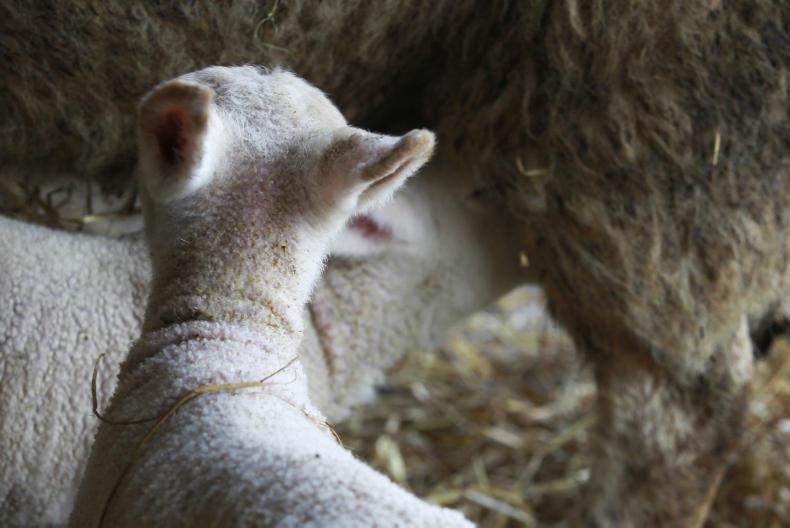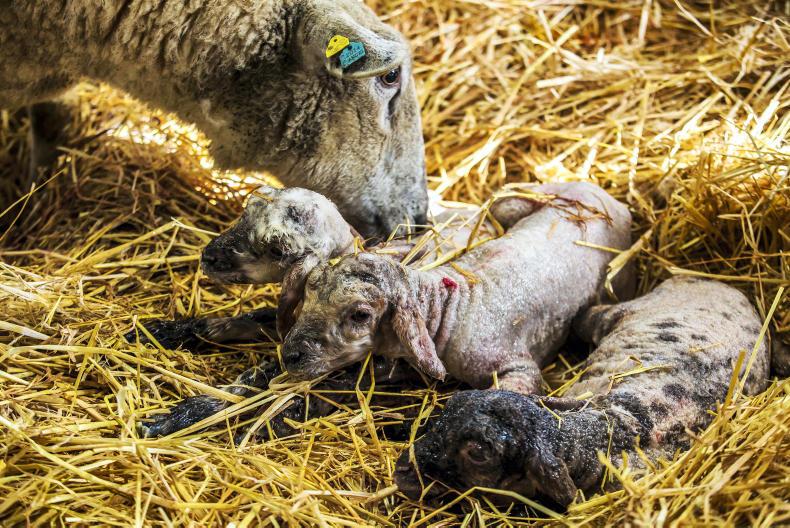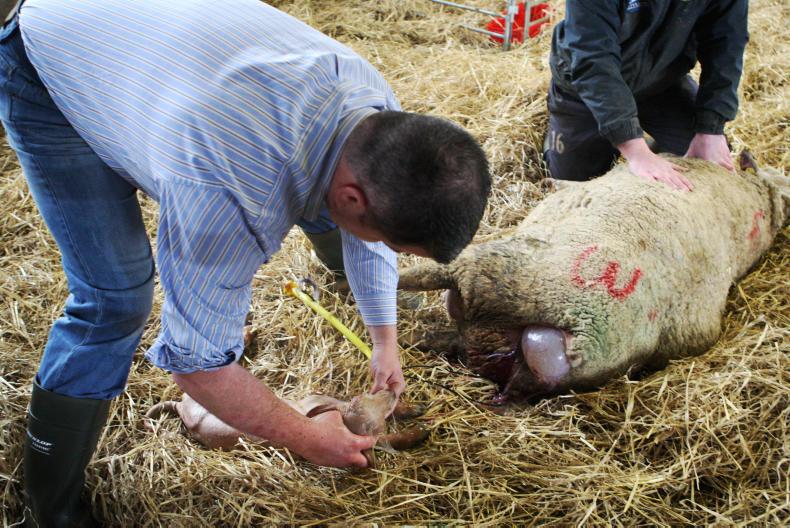Most lamb mortality occurs on the day of birth and up to 75% of deaths happen within the first week of life.
Losing lambs reduces profitability and staff morale. Time spent helping lambs to suck and mothering up is costly in terms of labour use.
Ideally, the ewe should bond with the lamb and raise it successfully to weaning with little human intervention.
Key to survival
The key to ensuring lambs survive is the early intake of colostrum by the lamb from the ewe.
This gives the lamb energy to maintain body temperature, immunoglobulins to fight off disease and helps bond the lamb and ewe together.

The key to ensuring lambs survive is the early intake of colostrum by the lamb from the ewe.
For suckling to occur, the lamb needs to be active at birth and the ewe needs to co-operate with the lamb so that it can find the udder and suckle.
The success of the ewe-lamb bond is affected by whether she has given birth before
The success of the ewe-lamb bond is affected by whether she has given birth before, whether the birth process was difficult or prolonged, her nutrition during pregnancy - especially the last third of pregnancy - whether there has been stress or disturbance during lambing, the size of the litter and the genetics of the ewe and lamb.
Sensitive to disturbances
Inexperienced ewes are more sensitive to environmental disturbances and more likely to abandon their lambs if disturbed.
Ewes that are good mothers to their first litter of lambs will continue to be good mothers in subsequent pregnancies.
Ewes lambing for the first time need a quiet and calm birth environment and will take longer to progress through labour and bonding with the lamb.
Inexperienced ewes are less able to rear multiple lambs compared with experienced ewes
Intervening too early can affect the development of the bond and may increase the chances of rejection.
Inexperienced ewes are less able to rear multiple lambs compared with experienced ewes.

A difficult or prolonged birth can delay the onset of licking the lamb by the ewe.\ Philip Doyle
A difficult or prolonged birth can delay the onset of licking the lamb by the ewe.
Also, a prolonged birth can result in brain damage in the lamb, which will make it slower to stand and suck.
This means the lamb may get less colostrum and, therefore, be at risk of hypothermia and starvation.
About 10% to 20% of all lambs may need some assistance at birth.
Risk factors
Risk factors for a difficult birth are lamb malpresentation, above-average birth weight, being male and genotype.
Within breed, the offspring of some rams will also need more birth assistance than others.
Aiming for optimal rather than heaviest birth weights will reduce the number of lambs needing assistance.
Stress during lambing can interrupt contractions and prolong birth.
Ewes like a quiet, calm and familiar environment
After lambing, disturbances may cause the ewe to leave the birth site before she has properly bonded with her lamb.
Stress during lactation reduces sucking interactions between the ewe and lambs and can make lambs grow more slowly.
Ewes like a quiet, calm and familiar environment, especially when they are lambing.
To reduce the impact of stress and disturbance on lambing ewes, avoid excessive noise and intervention, keep dogs and other animals out of the lambing environment and avoid mixing groups of unfamiliar sheep.
Do not over-stock pens and ensure that there is adequate feeder space to prevent injury around feeding time.
Low body condition score at lambing is associated with less maternal behaviour at lambing and a slower time to stand and suck in the lamb.
These are risk factors for a poor ewe-lamb bond and higher lamb mortality.
Good condition score
Maintaining a good condition score in ewes throughout pregnancy and regularly monitoring ewe condition will ensure that ewes are in the best condition to show good maternal care.
Trace elements and minerals are required by ewes only if there is a deficiency on the farm – supplementing ewes which already have sufficient supplies in their nutrition will not improve lamb survival.
Triplet lambs are generally smaller and slower to stand and suck
Most ewes, especially those that have lambed before, can cope well with triplets and increase their maternal licking with the birth of each lamb.
They form a new bond with each lamb and most will recognise when one lamb is not there.
Triplet lambs are generally smaller and slower to stand and suck, which makes them more vulnerable to hypothermia and starvation.
This means mortality in larger litters is higher than for singles or twins.
Pregnancy scanning ewes and feeding for litter size will help reduce this difference, but be prepared to provide extra care for multiple lambs as they may need additional colostrum and special attention to keep them warm.
As 75% of lamb mortality occurs within the first week of the lamb’s life, it is essential to manage the lambing ewe to reduce lamb mortality.
Early colostrum intake and ewe-lamb bond are key issues.
Avoiding stress and good nutrition are very important points for the lambing ewes, especially for inexperienced ewe.
Reducing assistance at birth is also a key factor.
Consider selecting animals with good survival traits by recording events at lambing and culling ewes that have problems.
Condition scoring and pregnancy scanning will also help you managing the lambing ewe and be prepared for those multiple births.
Ensure adequate colostrum intake by the lambs within the first 12 hours of life.Inexperienced ewes need all the biological signals to work at the right time to be good mothers: - low stress, good nutrition, time to progress, no interference from other ewes.Select for sheep that have good survival traits: - record; cull/don’t breed from ewes that have needed birth assistance more than once.Give the ewe time and space to do what they need to do - looking but not doing!Help the ewe to rear the lamb, so that you don’t have to.
Most lamb mortality occurs on the day of birth and up to 75% of deaths happen within the first week of life.
Losing lambs reduces profitability and staff morale. Time spent helping lambs to suck and mothering up is costly in terms of labour use.
Ideally, the ewe should bond with the lamb and raise it successfully to weaning with little human intervention.
Key to survival
The key to ensuring lambs survive is the early intake of colostrum by the lamb from the ewe.
This gives the lamb energy to maintain body temperature, immunoglobulins to fight off disease and helps bond the lamb and ewe together.

The key to ensuring lambs survive is the early intake of colostrum by the lamb from the ewe.
For suckling to occur, the lamb needs to be active at birth and the ewe needs to co-operate with the lamb so that it can find the udder and suckle.
The success of the ewe-lamb bond is affected by whether she has given birth before
The success of the ewe-lamb bond is affected by whether she has given birth before, whether the birth process was difficult or prolonged, her nutrition during pregnancy - especially the last third of pregnancy - whether there has been stress or disturbance during lambing, the size of the litter and the genetics of the ewe and lamb.
Sensitive to disturbances
Inexperienced ewes are more sensitive to environmental disturbances and more likely to abandon their lambs if disturbed.
Ewes that are good mothers to their first litter of lambs will continue to be good mothers in subsequent pregnancies.
Ewes lambing for the first time need a quiet and calm birth environment and will take longer to progress through labour and bonding with the lamb.
Inexperienced ewes are less able to rear multiple lambs compared with experienced ewes
Intervening too early can affect the development of the bond and may increase the chances of rejection.
Inexperienced ewes are less able to rear multiple lambs compared with experienced ewes.

A difficult or prolonged birth can delay the onset of licking the lamb by the ewe.\ Philip Doyle
A difficult or prolonged birth can delay the onset of licking the lamb by the ewe.
Also, a prolonged birth can result in brain damage in the lamb, which will make it slower to stand and suck.
This means the lamb may get less colostrum and, therefore, be at risk of hypothermia and starvation.
About 10% to 20% of all lambs may need some assistance at birth.
Risk factors
Risk factors for a difficult birth are lamb malpresentation, above-average birth weight, being male and genotype.
Within breed, the offspring of some rams will also need more birth assistance than others.
Aiming for optimal rather than heaviest birth weights will reduce the number of lambs needing assistance.
Stress during lambing can interrupt contractions and prolong birth.
Ewes like a quiet, calm and familiar environment
After lambing, disturbances may cause the ewe to leave the birth site before she has properly bonded with her lamb.
Stress during lactation reduces sucking interactions between the ewe and lambs and can make lambs grow more slowly.
Ewes like a quiet, calm and familiar environment, especially when they are lambing.
To reduce the impact of stress and disturbance on lambing ewes, avoid excessive noise and intervention, keep dogs and other animals out of the lambing environment and avoid mixing groups of unfamiliar sheep.
Do not over-stock pens and ensure that there is adequate feeder space to prevent injury around feeding time.
Low body condition score at lambing is associated with less maternal behaviour at lambing and a slower time to stand and suck in the lamb.
These are risk factors for a poor ewe-lamb bond and higher lamb mortality.
Good condition score
Maintaining a good condition score in ewes throughout pregnancy and regularly monitoring ewe condition will ensure that ewes are in the best condition to show good maternal care.
Trace elements and minerals are required by ewes only if there is a deficiency on the farm – supplementing ewes which already have sufficient supplies in their nutrition will not improve lamb survival.
Triplet lambs are generally smaller and slower to stand and suck
Most ewes, especially those that have lambed before, can cope well with triplets and increase their maternal licking with the birth of each lamb.
They form a new bond with each lamb and most will recognise when one lamb is not there.
Triplet lambs are generally smaller and slower to stand and suck, which makes them more vulnerable to hypothermia and starvation.
This means mortality in larger litters is higher than for singles or twins.
Pregnancy scanning ewes and feeding for litter size will help reduce this difference, but be prepared to provide extra care for multiple lambs as they may need additional colostrum and special attention to keep them warm.
As 75% of lamb mortality occurs within the first week of the lamb’s life, it is essential to manage the lambing ewe to reduce lamb mortality.
Early colostrum intake and ewe-lamb bond are key issues.
Avoiding stress and good nutrition are very important points for the lambing ewes, especially for inexperienced ewe.
Reducing assistance at birth is also a key factor.
Consider selecting animals with good survival traits by recording events at lambing and culling ewes that have problems.
Condition scoring and pregnancy scanning will also help you managing the lambing ewe and be prepared for those multiple births.
Ensure adequate colostrum intake by the lambs within the first 12 hours of life.Inexperienced ewes need all the biological signals to work at the right time to be good mothers: - low stress, good nutrition, time to progress, no interference from other ewes.Select for sheep that have good survival traits: - record; cull/don’t breed from ewes that have needed birth assistance more than once.Give the ewe time and space to do what they need to do - looking but not doing!Help the ewe to rear the lamb, so that you don’t have to. 







 This is a subscriber-only article
This is a subscriber-only article









SHARING OPTIONS: